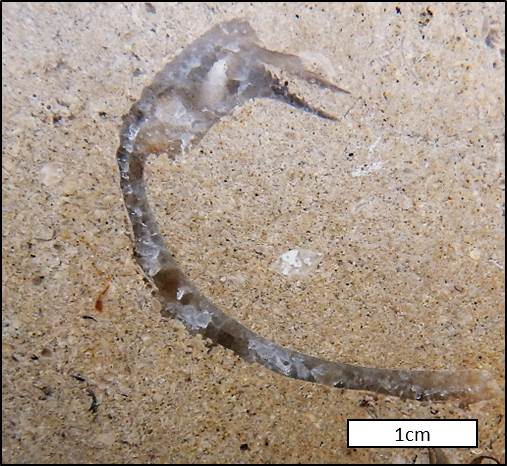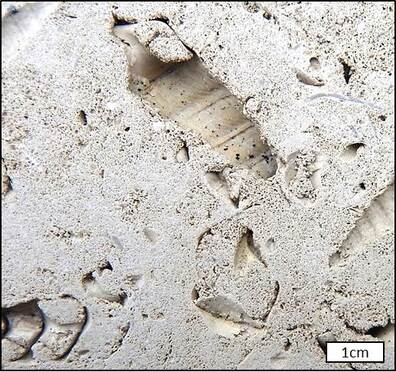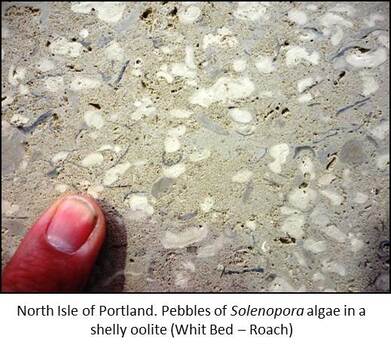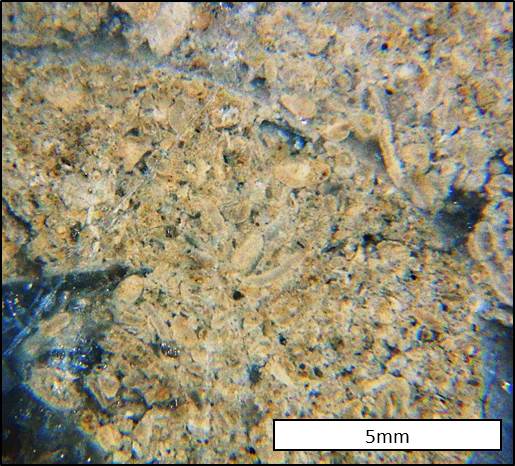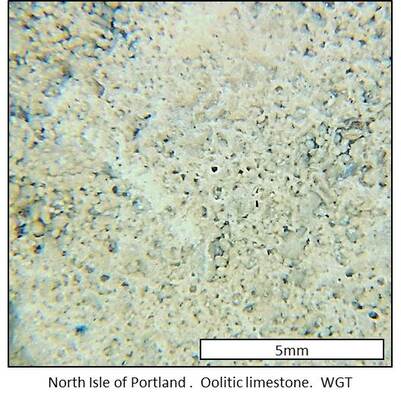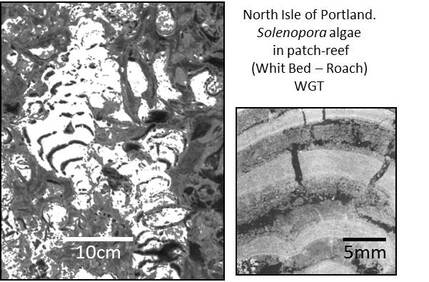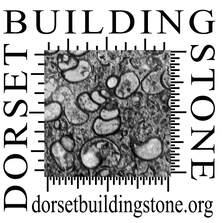Portland Stone Formation - Dorset (lead author: WGT)
The Portland Stone Formation (Portland Group) is the formal name for limestones in Dorset and Wiltshire, deposited in shallow seas about 149-145 million years ago (Late Tithonian/Middle Volgian). In Dorset the Portland Stone Formation is divided in two Members (Mbr) the Portland Chert Mbr overlain by the Portland Freestone Mbr. In both areas the marine Portland Group is overlain by the non-marine Purbeck Group. In Wiltshire (Vale of Wardour), it is divided in three, from bottom upwards, the Tisbury Mbr, the Wockley Mbr and the Chilmark Mbr. [See Portland Stone - Wilts]
|
The Portland Chert Mbr is a cherty shelly lime wackestone-mudstone, rich in calcite casts of Rhaxella sponge debris. It is of little use as a building stone but is currently crushed on the Isle of Portland as aggregate. The Chert was used for Stone Age tools. This member varies in thickness (10-30m) but underlies the Freestone Member throughout the outcrop from Durlston Head in the east to Portesham in the west and Portland to the south.
2. Dorset Central: Portland & Ringstead Bay to Lulworth Cove. Here the limestones are mainly shelly cross-bedded oolitic limestones, extensively quarried on the Isle of Portland and exported to London since 1650. During Medieval times, it is very likely that Portland Stone (and Lower Purbeck) was extracted from the coastal outcrop between Stair Hole and Worbarrow Tout. On Portland the quarrymen’s subdivisions (Base/Best Bed, Curf, Whit Bed, Roach) apply only in the northern area and it is only in this northern area that the distinctive alga Solenopora is common (diagnostic), as are algal/oyster patch reefs and their debris.
|
The Portland Freestone Mbr varies considerably in thickness (10-20m) and in composition across the outcrop - and in detail when exposed in 3D on the Isle of Portland (6-9m) There are three main rock types: Oolitic Limestones, Bioclastic Limestones and Shelly Lime Mudstones. There are three areas:
1. Dorset East: Coastal Isle of Purbeck. Known as “Purbeck Portland” (or “Purbeck Cliff Stone”) the freestones long quarried on the coast are shelly bioclastic limestones (biocalcarenites, rarely oolitic), with occasional Chert. Calcite-filled shell moulds are common (“spangle”). For more information on the Purbeck-Portland building stones, click HERE. The uppermost beds are shelly lime mudstones, capped by basal non-marine Purbeck limestones. From Worth to Bacon Hole, bioclastic limestones are interbedded with oolitic limestones. Dorset Central contd...The Roach is a local northern layer capping the Whit Bed containing empty moulds of bivalves and gastropods (unless silicified) – again diagnostic. This is a very durable rock used for harbour facings and sea defences (Lyme Regis Cobb, Portland Harbour).
|
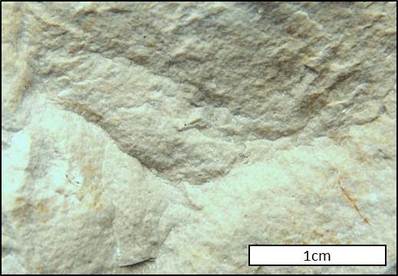 Poxwell to Portesham Lime mudstone. Image: WGT
Poxwell to Portesham Lime mudstone. Image: WGT
3. Dorset West: From Poxwell (3km from the oolites at Ringstead) to Portesham the Freestone Mbr is entirely lime mudstone with some chert layers and shell beds. Although used locally (e.g. Hardy Monument) this is not a durable rock type. The overlying basal Purbeck limestones are better building stones (See Cypris Freestones).
Gill Hackman's book "Stone To Build London" is a fascinating history of the quarrying industry on the Isle of Portland. To read more about the book click HERE. To read Geoff Townson's review of the book click HERE
Gill Hackman's book "Stone To Build London" is a fascinating history of the quarrying industry on the Isle of Portland. To read more about the book click HERE. To read Geoff Townson's review of the book click HERE

